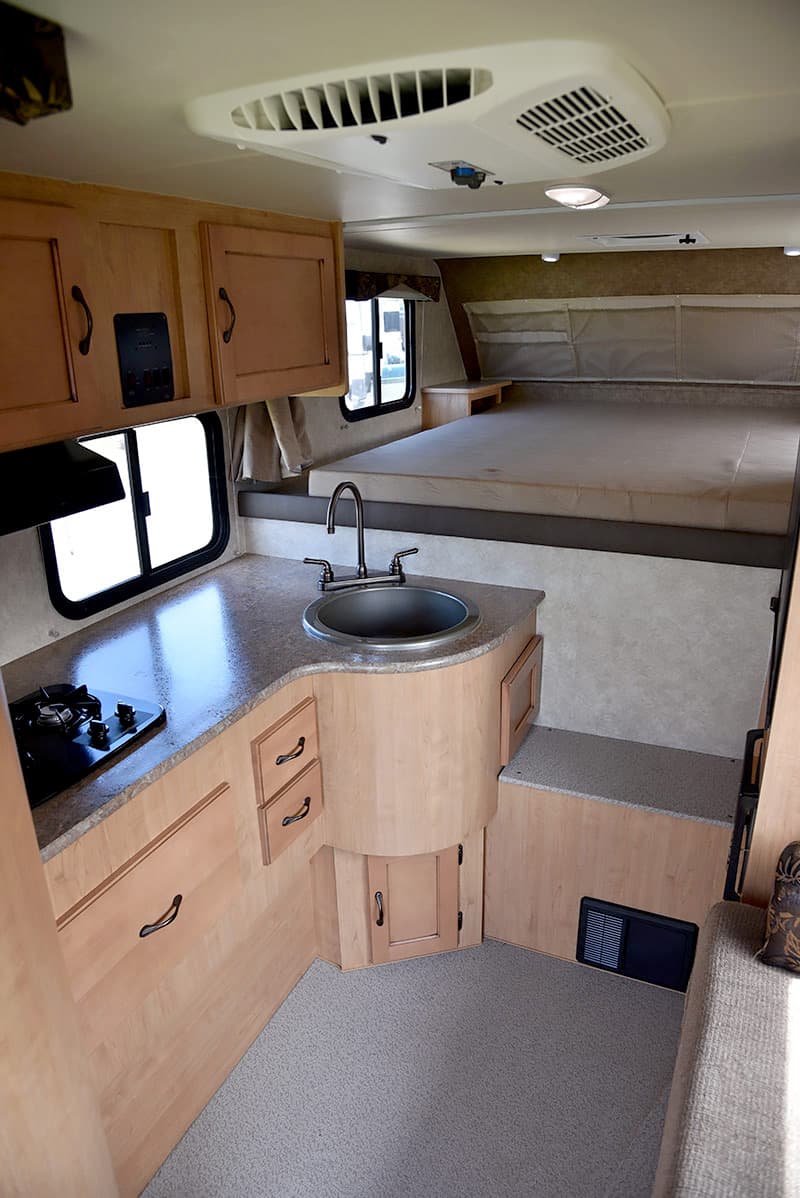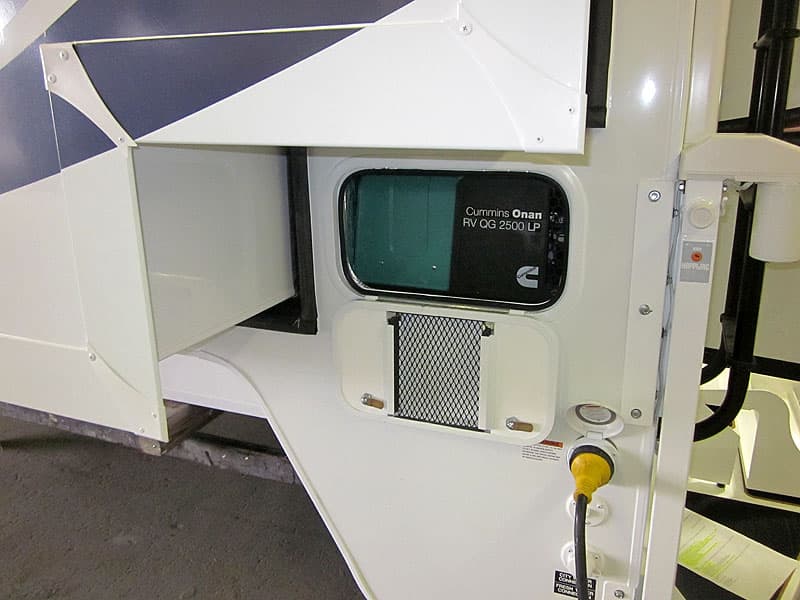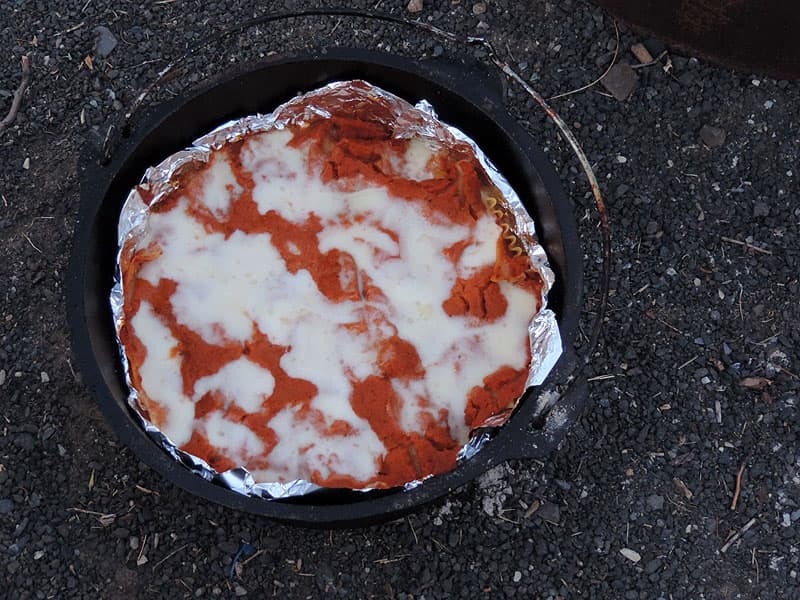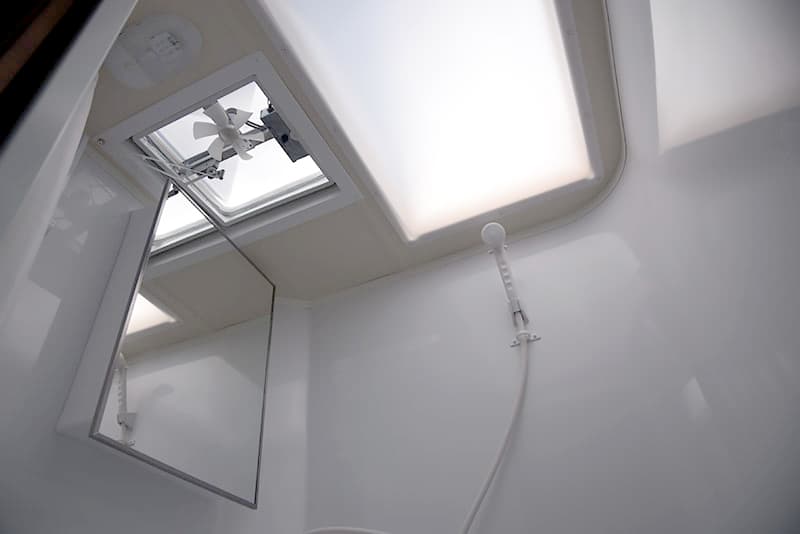Adventurer Manufacturing debuts the 2014 Adventurer 116DS, an all-new double-slide sofa camper with a rear kitchen slide, peninsula, and a California King bed. Get your dual recliners here!

The first thing we saw on the 2014 Adventurer 116DS was the floor plan. At first blush, the floor plan presented a lot of unique features to absorb. A rear kitchen slide? A mini-peninsula? A sofa that’s actually not located on the rear slide? A wet bath in a double-slide? And what is going on what that California King bed in the overcab?
Clearly the design team at Adventurer started with a blank page and a few cups of coffee when they designed this camper. There’s literally nothing even remotely like this floor plan available from the other camper manufacturers. Heck, this camper doesn’t even resemble anything else from Adventurer. This is one unique truck camper vision.
So, is this good news, or just truck camper design gone wild? To find out, we contacted Greg Tucknies, National Sales Manager for Adventurer Manufacturing. When we told Greg about our initial reaction to the camper, he explained that there’s a lot about this camper that can’t be seen in the floor plan. Greg even told us that you can get into the 116DS and access the bathroom, with both slide-outs in.
Remember when your teachers told you to not judge a truck camper by its floor plan? Well, according to Adventurer, they were right.

2014 Adventurer 116DS Specifications:
The 2014 Adventurer 116DS is a hard side, double-slide, wet bath truck camper made for long bed trucks. The interior floor length of the 2014 Adventurer 116DS is 11’6”, the interior height is 76” and the center of gravity is 55.5”. The 2014 Adventurer 116DS has a 44 gallon fresh tank, a 31 gallon grey tank, a 31 gallon black tank, and a 6 gallon hot water heater. It can accommodate two batteries and has two twenty-pound propane tanks. Adventurer is reporting the base weight of the Adventurer 116DS to be 3,920 pounds with no options. The base MSRP for the 2014 Adventurer 116DS is $35,455.
 |
 |
 |
Above: The exterior of the 2014 Adventurer 116DS
The 2014 Adventurer 116DS is shown on a single rear wheel truck for demonstration purposes only. For proper truck and camper matching, read “Matching a Truck and Camper“.
The following interview is with Greg Tucknies, National Sales Manager for Adventurer Manufacturing, on the 2014 Adventurer 116DS.
TCM: Why is Adventurer debuting a double-slide truck camper?
Greg: For 2014, we’re making some changes to Adventurer’s floor plans. We are eliminating some slow sellers and coming out with new models. For starters, the Adventurer 106DBS and 980RDS models are being discontinued. To replace those larger models, we are debuting the 116DS double slide.
Adventurer dealers have been requesting a larger double-slide unit with the Adventurer theme; high value, low price, and light weight. When we start working on a new floor plan, we put our engineering team to the task with a wish list. The wish list is created from conversations with dealers and customers as well as our own vision.
 |
 |
 |
 |
 |
 |
 |
 |
 |
Above: Photographs of the 2014 Adventurer 116DS on the assembly line.
From the beginning, we knew we wanted to build a double-slide with a sofa, a California King bed, and optional theater seating that reclined. To get everything on our wish list while maintaining the goal of high value and light weight was a challenge, but we did it with the 116DS.

Above: The wet bath in the 2014 Adventurer 116DS
TCM: We were a little surprised to see a wet bath in a double-slide floor plan. We happen to prefer wet baths for their efficient use of space, but most larger truck camper models have dry baths. What led Adventurer to put a wet bath in the 116DS?
Greg: There are two reasons why we went with a wet bath in the 116DS. First, we had several requests from Eagle Cap customers for a wet bath in a larger floor plan. Not everyone wants a dry bath.
Second, dry baths in truck campers take up a lot of space. If we had gone with a dry bath in the116DS, we would not have been able to feature a sofa or recliner theater seating. This camper needed a sofa or it would not be as popular, and I think folks are really going to love the recliner theater seating.
 |
 |
 |
Above: The rear kitchen slide and mini-peninsula in the 116DS
TCM: The mini-peninsula is another unique facet of the 116DS. Where did that idea come from?
Greg: When we were designing this camper, we wanted as much floor space as possible, and room for a sofa. That criteria led us to put the kitchen in the rear of the camper.
The idea for the peninsula came from our Eagle Cap 1165. Having the mini-peninsula opened up the kitchen, gave the camper more storage, and made the kitchen more ergonomic to use. Making it a smaller peninsula avoided taking up valuable floor space. Another benefit of this floor plan is that you can get into the unit with all the slides in the in position.

Above: The 116DS side entry door open with the rear slide-out in
TCM: That’s interesting because the floor plan doesn’t look like you could get past the refrigerator with the rear slide in.
Greg: It doesn’t look like you could get in from the floor plan. I can confirm that you can indeed get into the camper and reach the bathroom with both slides in.

Above: Jim DeBord, National Sales Representative, shows how it’s possible to reach the bathroom in the 116DS with the slide-outs in

Above: Greg Tucknies squeezes past the sofa to enter the 2014 Adventurer 116DS with the rear slide-out in

Above: Jim DeBord accesses the mini-peninsula with the rear slide-out in
In the picture you see that Jim can stand between the kitchen and the peninsula with the slides closed. Even the refrigerator is accessible with the slides in. There’s a lot about this camper that you can’t see in the floor plan.
TCM: Going down the road, with the refrigerator on the back wall, is there any concern about the refrigerator’s pilot possibly blowing out?
Greg: There’s a baffle enclosure around the pilot in the refrigerator, so that shouldn’t be an issue.
 |
 |
 |
Above: Assembling the above the rails basement in the 2014 Adventurer 116DS
TCM: Is the floor of the 116DS above the truck rails?
Greg: Yes, the 116DS is built above the rails. To maximize the available floor space, we are building above the rails. It gives the camper a more open feeling and offers more space in a double slide.
The camper would lose a lot of space if we didn’t build the floor above the rails. The sofa is a prime example. If the camper floor was above the wheel wells, we wouldn’t be able to have the sofa or recliner theater seating. For this floor plan to work, building above the rails was a necessity.

Above: The new optional theater seating put to the test
TCM: Tell us about the optional theater seating.
Greg: Theater Seating is a new option for Adventurer and Eagle Cap for 2014. It consists of two home theater style recliners and a drink/remote tray between them.
Above: An Adventurer Manufacturing video presenting theater seating
I saw the theater seating a year and a half ago in a travel trailer. I brought the idea back to our design team and said that we needed to implement it into a truck camper.
 |
 |
 |
Above: The standard sofa (left and center) and optional theater seating (right)
In the 116DS, you lose the extra sleeping area of the sofa, but the recliners are what people are asking for. The theater seating is really nice. I think our customers are going to love it.
TCM: From the floor plan, the television is located just inside the cabover on the driver’s side. Can you see the television from the sofa or theater Seating?
Greg: Yes, you can. The television has a triple swivel arm so you can see it from both positions in the sofa and from both recliners. I was sitting next to the bathroom on the sofa and could see it easily in fact I could see it easily from the full reclined position in the recliner by the bath wall. For 2014, we also went to a twenty-four inch HDTV television.

Above: The rear kitchen slide on the Adventurer assembly line
TCM: What slide mechanisms are you using on the 2014 Adventurer 116DS?
Greg: We believe in using the best technology, products, materials in the right area for the right purposes. We’re using the Schwintek mechanism for the lighter rear kitchen slide and a more traditional Happijac mechanism for the heavier dinette slide.
We are still not comfortable with the Schwintek for the heavier dinette slides. The dinette slide is heavy, especially when theoretically there could be four to five adults in the dinette. We need a heavy duty slide mechanism in that area.

Above: Measuring the center of gravity point on the 116DS
TCM: Even with the rear kitchen slide being lighter in weight, how does having the refrigerator, range oven, and cabinetry in the far rear affect the center of gravity in the 116DS?
Greg: Those are some relatively heavy items, but we have stacked the grey and black tanks in the very front wall of the basement and placed the batteries all the way forward. The cabover is also extended about ten inches and there are overcab cabinets over the bed along the front nose. All of this adds up to a center of gravity at 55.5”.
When the camper is wet and loaded with water and batteries, the center of gravity should be three to four inches in front of the rear axle. We are very conscious about weight and center of gravity when we design and build our campers.

Above: Every Adventurer gets a red center of gravity sticker as it comes down the line
TCM: We love those red center of gravity stickers. Every camper should have one. Looking at the floor plan, it appears that it could be tight between the sink in the mini-peninsula and the stove.
Greg: It’s actually quite open in person.

Above: Greg Tucknies stands behind the mini-peninsula with the rear slide-out in
I can actually stand between the sink and oven with the kitchen slide-out closed in. That was not planned, but we realized this was possible when the camper was physically built. We are thrilled at how functional the camper remains with the slide-outs in.

Above: The refrigerator in the 116DS is a seven-cubic foot model
I should mention that we are using a larger seven-cubic foot refrigerator in the 116DS. In the past we have used six-cubic foot refrigerators. It’s surprising how much difference one cubic foot makes in a refrigerator.
 |
 |
 |
Above: The 2014 Adventurer 116DS features large windows
To make the camper feel bigger we put in large windows all the way around this unit. It feels bigger than any camper we build. It’s the best of both worlds with the peninsula kitchen, the dinette, and sofa or theater seating.

Above: The California King bed in the 116DS overcab bedroom
TCM: Why does the 116DS feature a California King bed?
Greg: No other truck camper manufacturer is offering a California King and we have had lots of requests over the years for a king size bed. We built this camper from scratch so we decided to not only offer a king size bed, but a 72” x 84” California King bed.
The overcab feels very open and, because we built over the rails, it’s easy to access the cabover. You literally just sit down to be in the cabover area and scoot onto bed. The cabover is much lower in height than campers built above the wheel wells.

Above: The mirrored wardrobe in the 116DS overcab bedroom
TCM: There seem to be some compromises with storage in the 116DS. Talk to us about how you balanced features against the need for storage in the camper.
Greg: There’s always a tradeoff between features and storage. That said, the overcab features a large wardrobe, a night stand area, and storage along the front nose. The kitchen features a lot of cabinetry storage including a big drawer under the oven and another drawer under the refrigerator.
Under the sink there is a big open shelf for large items. There are also two deep drawers under the dinette seating area and a drawer under the sofa and cabinetry above the sofa as well. When you see the camper for yourself, you’ll be impressed with how much storage the 116DS offers.
TCM: In an email to us you stated that the 116DS features dual sleeper windows. Are those the driver and passenger side windows in the cabover?
Greg: Yes. In the Adventurer 89RB and 86SBS we have gone to a big wardrobe on the passenger’s side cabover and lost the cabover window. Customers have asked for dual windows in the overcab. We still wanted the big wardrobe, so we moved the wardrobe aft and added a passenger’s side cabover window for cross ventilation, and a night stand.

Above: Jim DeBord inside the 116DS rear basement storage area
TCM: Speaking of storage, you also mentioned a large basement storage area.
Greg: On the exterior, the 116DS has big double doors like the larger Eagle Cap models. They are barn-style doors. We listen to our customers. They requested room for longer storage items like skis and fishing poles. There is a deep section behind the fresh water tanks for these items. Basement storage is a real strength of this camper.
TCM: Are all lights on the 116DS all LED?
Greg: Yes they are. For 2013, all Adventurer truck campers featured LED lights, except for the overcab reading lights. For 2014, we now have LED reading lights in the overcab. Now the entire unit inside and out features LED lighting.

Above: Adventurer Manufacturing’s scale weighed the 116DS at 4,196 pounds dry
TCM: Adventurer is to be commended for weighing each and every truck camper as it leaves the factory to give the customer an honest dry with options weight. What did the 2014 Adventurer 116DS weigh with standard build options as it left the factory?
Greg: The base weight of this camper is 3,920 pounds. The standard build weight is 4,196 pounds. You can now build the 116DS on the Build Your Own section of our website: http://www.amlrv.com/build-your-own-page.
TCM: How accurate has the Build Your Own system proven to be?
Greg: Our goal is to pinpoint the camper weight within 100 pounds. We have done spot checks in the past year and the closest weight has been within three pounds and the worst has been 126 pounds. This is still a new system for Adventurer. We need to find out which options we’re light on. We want to be under the 100 pound mark with every camper that comes off the line.
TCM: What is the MSRP for the 116DS with standard build options?
Greg: The base price of the 116DS is $35,455 and the price with standard build options is $39,507.
TCM: When will the 116DS be available?
Greg: It is starting to ship now. Five Star RV in Denver, Colorado, Fraserway in Abbotsford, British Columbia, SCATT Recreation in Roseville, California, Princess Craft in Round Rock, Texas, U-Neek RV in Kelso, Washington and Truck Camper Warehouse in West Chesterfield, New Hampshire have all ordered the 116DS and will have them soon.

Above: Checking the design and fit of Adventurer 116DS basement
TCM: We found the picture of the basement on the truck interesting. What were you doing there?
Greg: We did that to make sure the computer design and specifications were on target. It’s amazing to me how the computer renderings have been so accurate. But we want to make certain the camper is going to clear tail lights and bed rails. The computer renderings are impressive, but we still test things in the real world.
TCM: Now that you’ve conquered the double slide, are you planning to build an Adventurer triple slide?
Greg: There are no plans for an Adventurer triple-slide at this point. In 2014 we looking to debut more innovative single-slide units. With the double-slide, we want the price point to be the low. To my knowledge it will be the lowest priced double slide on the market.

Above: Rear to front interior photograph of the 116DS
TCM: What are some features that the 116DS has that will also be included in your 2014 Adventurer truck campers?
Greg: Adventurer campers will have Lamilux 4000 exteriors and our new exterior graphics. We have also dropped the Camel interior and added maple with leather style accents. As I stated earlier, we now have seven cubic foot refrigerators in our models that had six cubic foot refrigerators. We have also added a Heki skylight and an upgraded stereo as options.

Above: The 2013 Adventurer 116DS 4-Season Certified sticker
TCM: Is there anything about Adventurer the 116DS that you would like to add to your interview?
Greg: Adventurer is always striving to be the weight and value leader. We continue to have our three year structural warranty on all Adventurer products. We are growing the market and meeting the demands of our consumers. Many dealers have contacted us to take on the product.
We are excited and have a lot more to share for 2014. In a few weeks we will announce in Truck Camper Magazine a new nine-foot dry bath model. Stay tuned!
To view a walkthrough video of the 116DS, visit Adventurer’s YouTube channel at http://www.youtube.com/user/AMLRV.
For more information on the Adventurer 116DS, please visit their website at www.amlrv.com.
The post 2014 Adventurer 116DS Double Slide appeared first on Truck Camper Magazine.























































































































































































































































































































































































































































































































































